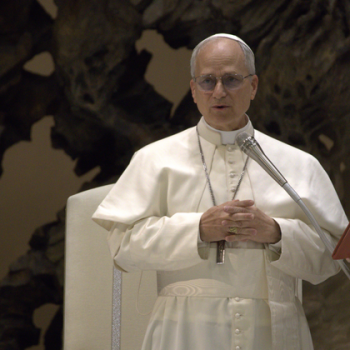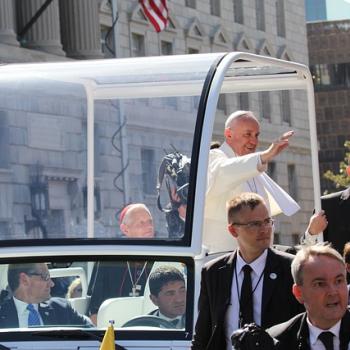Editors' Note: This article is part of the Patheos Public Square on Myth, Imagination, Fairy Tales, and Fantasy. And Faith. Read other perspectives here.
When asked to reflect on imagination, myth, fantasy, and faith, I first thought of Charles Dickens, whose fertile imagination ignited the modern myth of Christmas. However, since I already explored that myth in Changing Signs of Truth (2012), I decided to follow a clue offered by David Leeming in his book Mythology. William Wordsworth and Samuel Taylor Coleridge, he suggests, echo Native American mythmakers: "the articulator of myth, the one who gives voice to the human soul through language, is the shaman and his descendant the wild-eyed poet."
Born in 1770 and 1772 respectively, Wordsworth and Coleridge, like many of their generation, experienced their first religious passion during the French Revolution. The fall of France's ancien régime, symbolized in 1789 by the fall of the Bastille, provided a salvation myth they could believe in: liberty, equality, fraternity. After the revolutionaries renamed Notre Dame Cathedral the "Temple of Reason," Coleridge's friend Robert Southey explained the new mythology with biblical diction: "Old things seemed passing away, and nothing was dreamt of but the regeneration of the human race."
When this fantasy was shattered in 1793 by the Reign of Terror, Southey and Coleridge decided to create their own utopia in Pennsylvania: a place where Native American shamans followed a more ennobling mythology. Coleridge explicitly describes their imagined paradise as a place where "Wizard Passions weave an holy Spell." However, unable to raise funds to emigrate, Southey and Coleridge had to abandon their fantasy.
Not long afterward, Coleridge met Wordsworth, with whom he explored a new kind of fantasy: the power of imagination to create, if not physical utopias, "holy Spells" through poetry. They shared a similar dissatisfaction with the ancien régime of British "neoclassicism," which elevated Greek and Roman genres as the nobility of literature. Upholding strict rules about proper "poetic diction," neoclassical poets regarded myth as a well-stocked warehouse of Greek and Roman allusions from which they could borrow references for their odes and elegies: a mythology understandable only to the well-educated upper classes. In 1798, Wordsworth and Coleridge stormed this neoclassical Bastille through their anonymous publication of Lyrical Ballads. Rather than privileging classical mythology, their poems inculcated what scholars call a "myth of nature," celebrating uneducated rustics who can directly experience its mystical power.
Lyrical Ballads opened with Coleridge's "Rime of the Ancient Mariner," in which a sailor defies nature by killing an albatross guiding his ship toward safety. The albatross — a symbol of salvation through nature — is hung around the mariner like a noose. Only when the mariner sees "beauty" in "slimy" water-snakes, blessing them "unaware," can he pray, releasing the albatross from around his neck. Toward the close of the poem, Coleridge clearly aligns belief in the mythic power of nature with religious faith:
He prayeth best, who loveth best
All things both great and small;
For the dear God who loveth us,
He made and loveth all.
The childlikeness of the language, in defiance of neoclassical poetic diction, is part of the point: one must become like a child to appreciate what Coleridge elsewhere calls "Religious meanings in the forms of Nature." Eschewing the French Temple of Reason, he celebrates the landscape as a "magnificent temple" dedicated to "adoration of the God in nature."
Wordsworth expresses a similar adoration in the poem that ends Lyrical Ballads, "Lines Composed a Few Miles above Tintern Abbey." Calling himself "A worshipper of Nature," Wordsworth asserts that meadows and woods contain "A motion and a spirit, that impels / All thinking things." And, as in other religions, this holy spirit serves as
The anchor of my purest thoughts, the nurse,
The guide, the guardian of my heart, and soul
Of all my moral being.
Many scholars bemoan the fact that Wordsworth and Coleridge sacrificed this myth of nature as they aged, both reverting to Christian orthodoxy. However, such critique misses how the two harmonized their mythology with Christian faith. Coleridge did so from the very start, regarding his imaginative mythmaking as a performance of the imago Dei suggested in Genesis: "So God created man in his own image, in the image of God created he him" (KJV, 1:27). If God, as outlined in Genesis, is Creator, then humans are most God-like when they creatively respond to creation. Coleridge put it this way in 1817: "The primary IMAGINATION I hold to be the living Power and prime Agent of all human Perception, and as a repetition in the finite mind of the eternal act of creation in the infinite I AM" (emphasis his). The creation of a nature myth echoes the continuous creativity of Yahweh, who carries the name "I AM that I AM." Religion and myth become one as worshippers imaginatively respond to a Creator manifest in nature.
3/9/2016 5:00:00 AM




